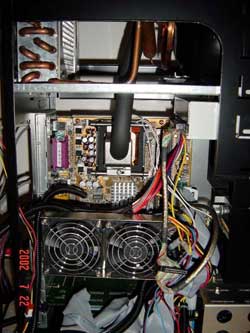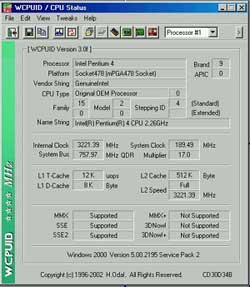|
|
|
|
|
Abit BD7-II RAID (i845E P4) Motherboard |
|
Join the community - in the OCAU Forums!
|
Overclocking with the Vapochill
Overclocking with Vapochill Cooling System:
Finally we mounted the BD7-II in our Vapochill case and prepared our P4 2.26 for the great freeze. A short introduction into the Vapochill technology (from the Asetek website):
The VapoChill cooling system works like a household refrigerator. An evaporator is transferring the heat from the CPU into the refrigerant. The warm, gaseous refrigerant is sucked from the evaporator into the compressor, where the pressure is raised to the condensation pressure of the refrigerant in order for the phase change to occur. The heat gathered from the evaporator is expelled through the condenser, where the refrigerant is liquefied in the process. In order for the refrigerant to evaporate again it is necessary to lower the pressure using some sort of valve. By using a capillary tube (i.e. a tube with a small inner diameter) the same pressure drop can be obtained, before being sent into the evaporator.
In our case when running the P4 2.26 with high over- voltage at 1.85 volt, the evaporator was at minus 17 C and the CPU at minus 1C. Reducing the voltage and the frequency is naturally decreasing the CPU temperature further.
As already mentioned earlier the BD7-II is with just 215 mm x 305 mm a rather small board. Recently we had problems installing other, bigger boards like the A7V333 in the mid-tower Vapochill case. The smaller BD7-II however fits perfectly. The BD7-II CPU socket is also well located for the perpendicular placement of the evaporator on the CPU die or on the heat spreader in case of a P4. The BD7-II is certainly a good choice for the use with the current Vapochill system.

A vapochilled system has 2 advantages. Firstly and most important: the CPU overclocks higher because of its much lower temperature. Secondly at the same frequency a vapochilled CPU runs more stable than an air-cooled CPU. With the vapochilled 2.26 on the BD7-II we could boot into Windows 2000 at 3221 MHz. This is around 140 MHz more than the maximum CPU frequency we achieved air-cooled. The additional speed we gained with the P4 is relative smaller than with our previously vapochilled Athlons. The reason is obviously that the cooler running P4 is already air-cooled closer to its maximum headroom than the hotter running Athlon XP. Or with other words: the hotter running XP benefits more form the Vapochill deep freeze than the anyway cooler running P4. In order to run our benchmarks stable we had to scale back the CPU frequency from 3221 to 3145 MHz.

The additional CPU speed of around 120 MHz attained with the Vapochill cooling system gave as around 5% additional application performance on top of our best results with the air-cooled P4 2.26.
|
|
Advertisement:
All original content copyright James Rolfe.
All rights reserved. No reproduction allowed without written permission.
Interested in advertising on OCAU? Contact us for info.
|

|


